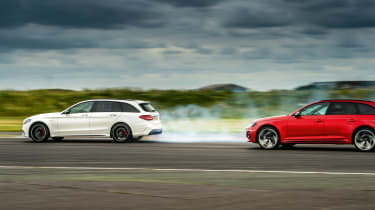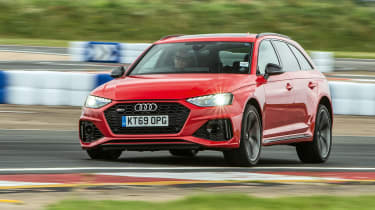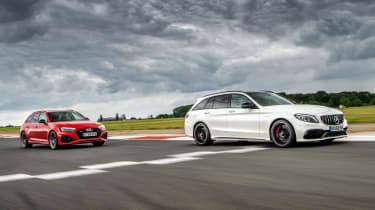Mercedes-AMG C63 S Estate v Audi RS4 Avant – junior estates go head-to-head
The Mercedes-AMG C63 S Estate and Audi RS4 Avant both combine practical bodies with punchy performance. But which of these junior super-estates is the most entertaining, and does that also make it the best road car?
So there’s this corner on the West Circuit at the Bedford Autodrome that always separates the wheat from the chaff. It’s not so much a corner as a high-speed chicane, and it comes towards the end of the lap, just when you’re (hopefully) thinking: ‘Right, this has been a good one, so let’s not blow it here – keep it nice and tidy.’
The approach speed is high, as in 100mph-plus in fourth gear, and in most cars you’ll probably want to downshift to third just before you turn in, although in high-torque cars – such as the Audi RS4 and Mercedes-AMG C63 S – you’re better off staying in fourth and nailing the throttle as early as possible towards the exit.
> When Audi first humbled Porsche – evo Archive
Before you can get anywhere near doing this, however, you need to manage the turn-in phase, which is crucial because it’s followed by a serious transfer of weight in the middle of the chicane as you flick decisively from left to right. Get this corner right and it feels delicious. Get it wrong and you’d better hope the ESP system on whatever car you’re pedalling is good, and is on your side. Except, of course, we usually turn such systems off when possible to generate the quickest lap times, meaning you’re very much on your own…
So it’s a key corner, and the way in which the recently revised Audi RS4 Avant and the well-established Mercedes-AMG C63 S Estate deal with it is intriguing, because here, possibly more than anywhere else, they behave quite differently from one another. The reason why, of course, is because the RS4 is four-wheel drive whereas the C63 S remains rear-wheel drive, and although most of the time – on the public road for example – you’d be hard pushed ever to spot the difference, on track, and especially on this specific corner, they really are like chalk and cheese.
The Audi feels planted, secure and stable but ultimately just understeers a bit when you turn in, then understeers a bit more when you change direction. The AMG, on the other hand, is more responsive and alert on turn in, and during the shift in direction. It feels far lighter on its feet but also like it could get away from you more readily if you do the wrong thing with the throttle at the crucial moment. It dances in a way that the RS4 does not, and is a fair bit faster through this corner sequence as a result, but it also requires more skill to keep in check and more bravery in terms of your commitment to the throttle.
Which is the better car through here? The AMG, no question. Yet for someone who still wants to go quickly without needing to go anywhere near the edge, the RS4 has a lot going for it. So it’s up to the individual behind the wheel which approach, and therefore which car, you might prefer. And this is a theme that pervades throughout this comparison from start to finish.
But before we delve deeper into the dynamic differences between these cars, some brief bits of housekeeping, because there are some crucial elements that separate this pair in the showroom. Like the fact that the Audi costs almost ten grand less than the AMG, despite boasting a pretty much identical amount of kit inside plus a highly sophisticated four-wheel-drive system on top. That said, the RS4 tested here has an on-the-road price of £81,600 with options, many of which you’d surely plump for when specifying an RS4, such as the deeply sexy 20-inch wheels, the full-house sports exhaust system and the various carbonfibre bits and bobs inside. So in reality they are closer to one another on price than they might at first appear.
What separates them more obviously is the engine and transmission specs. The RS4 has a twin-turbo 2.9-litre V6 that produces 444bhp and 442lb ft and is mated to an eight-speed dual-clutch gearbox. The AMG uses the ubiquitous 4-litre twin-turbo V8 that also appears in most Astons as well as most AMGs, and it produces 503bhp and 516lb ft. In this case it’s mated to AMG’s new nine-speed dual-clutch ’box – one of the few mechanical things to have changed on the C63 since it was unleashed in 2015.
The differences continue inside, the AMG feeling busier, with more buttons and switches to play with (or get confused by) both on the centre console and on the steering wheel. The RS4 is simpler and more intuitive by design, its new MMI central touchscreen being similar to that of the AMG but also easier to use. Both cars feel high on quality inside, but the RS4 especially so.
Then you fire them up and start to drive them hard, and the AMG’s more bombastic personality bursts to the fore, at which point the RS4’s overall appeal doesn’t so much wane as merely alter in stature within your subconscious. It doesn’t cower beside the AMG but no longer does it seem quite so butch, despite being the more muscular of the two visually, what with its He-Man Quattro-esque rear arches and those enormous wheels and tyres contained within.
Beside the Merc the Audi instantly sounds quieter and appears more restrained than it actually is, but only because the exhaust noise the AMG emits dwarfs the RS’s by comparison. Same goes for the Audi’s straight-line performance. In isolation it feels, and indeed is, a seriously rapid car. The 0 to 62mph claims are identical at 4.1sec, yet because the Merc is that much more dramatic in everything it does, subjectively it feels the quicker of the two. It’s also just better suited to lapping the likes of the West Circuit, due in part to the RS4’s mildly inert on-limit handling characteristics but mainly because the AMG is fundamentally a rear-wheel-drive hot-rod at heart.
On a track such as this, the first thing you do in the AMG is thumb the ESP/traction control button to off (you do the same in the RS4 to be fair, although doing so has far less effect than it does in the Mercedes), then you go hunting for a corner through which you can indulge yourself in the AMG’s ability to go sideways seemingly for a hundred yards or more, and at that point the key differences between the two cars become blindingly apparent. Not only is the C63’s steering sweeter and more detailed in its feedback, the chassis also feels much better balanced front to rear, side to side, in yaw, under braking or even during acceleration; you name it, in every single dimension the AMG feels more alive and more responsive than the RS4. And it sounds twice as tasty in the process, with a hard-edged growl to its exhaust note that the more refined, quieter RS4 can’t compete with. Which begs another question: why does this engine sound so much fruitier in AMGs than it does in Aston Martins when surely it should be the other way round?
Anyway, I digress. Point is, the AMG is unquestionably the more indulgent and is just the better car to drive on a track, and by some margin. However, out on the public road the roles reverse, the RS4’s smoother ride and arguably more sophisticated dynamic personality putting the AMG right back in its place. The Audi undoubtedly feels far more suited to the road than it does the track, the AMG’s skateboard ride letting it down quite badly beside the RS4, even with both cars’ drive programmes set to maximum comfort.
You could therefore argue that the RS4 is the better car for the real world, the world in which the ability to pull gigantic powerslides and to lap circuits faster has no great relevance to anyone, given that these are fast estate cars we’re comparing here, not a pair of hypercars or stripped-out lightweights. And in most respects you’d be entirely right to think that. But give me the choice and I’d go for the AMG every time, because while its on-road ride isn’t great, it isn’t that bad, either. And when the time comes to truly let rip in them, it remains in a different league, despite the RS4 being a very good car indeed. In isolation.
Audi RS4 Avant v Mercedes-AMG C63 S Estate specs
| Mercedes-AMG C63 S Estate | Audi RS4 Avant | |
| Engine | V8, 3982cc, twin-turbo | V6, 2894cc, twin-turbo |
| Power | 503bhp @ 5500-6250rpm | 444bhp @ 5700-6700rpm |
| Torque | 516lb ft @ 2000-4250rpm | 442lb ft @ 1900-5000 |
| Weight | 1670kg | 1745kg |
| Power-to-weight | 306bhp/ton | 259bhp/ton |
| 0-62mph | 4.1sec | 4.1sec |
| Top speed | 180mph | 155mph (limited) |
| Basic price | £75,458 | £65,700 |







